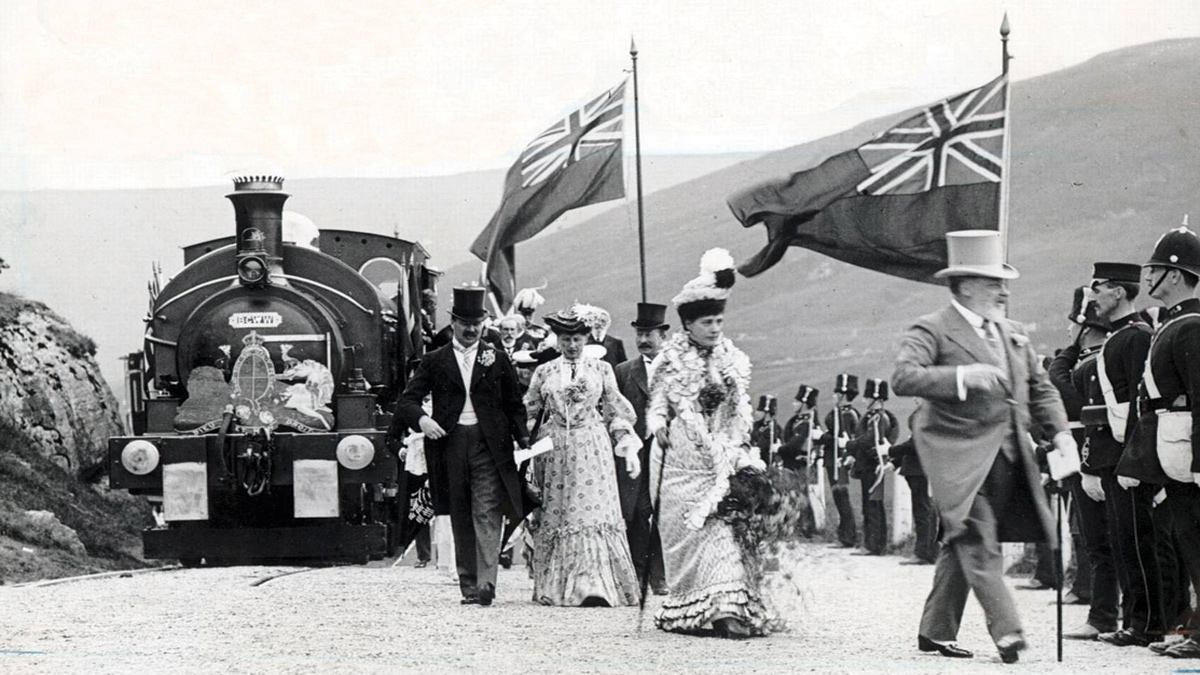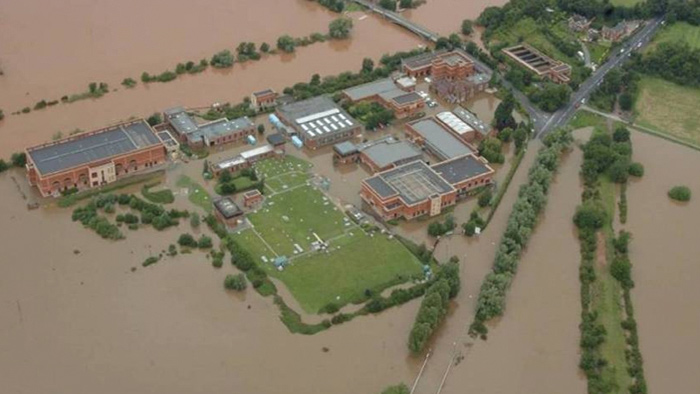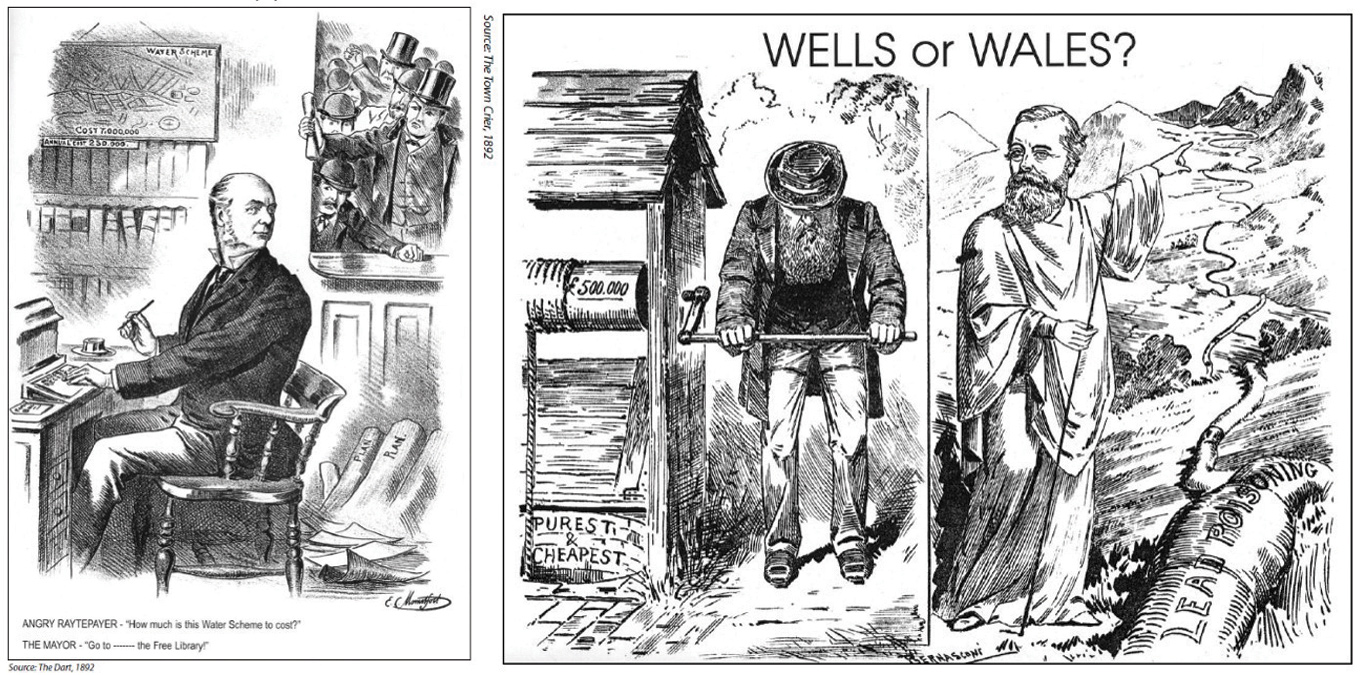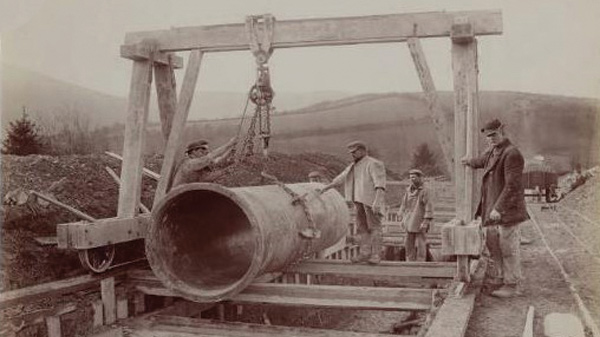BRP – Challenges – Birmingham Resilience Project (2016)

King Edward VII at the opening ceremony of the Elan Valley Reservoir complex and aqueduct on 21 July 1904. In the background is Birmingham Corporation’s own steam locomotive – part of the railway built to service the works - Courtesy of Severn Trent Water
The construction, in the late 19th century, of the Elan Valley reservoir complex and aqueduct was one of the greatest engineering feats of its age. It was a visionary project which saw civic authorities in Birmingham identify and respond to need, ahead of their rivals, using cutting-edge techniques to transform lives in the West Midlands and Wales. In response to an imminent crisis in water supply, the Birmingham Corporation dammed the Elan Valley and constructed a 73 mile aqueduct to channel water downhill to the city. Today, some 112 years since the aqueduct first transported water to Birmingham, Severn Trent Water is about to embark on their most ambitious capital project yet, the Birmingham Resilience Project, to provide an alternative water supply for Britain’s second city. This paper explores some of the challenges faced by the Victorian pioneers and the parallels in the modern age.
Background
Like other cities, Birmingham faced a huge task in keeping itself supplied with clean water in the latter half of the 19th century. Growing industrialisation saw the city’s population increase from 75,000 in 1801, to around 230,000 fifty years later and 520,000 at the turn of the century, while the population of the wider Birmingham area was 1,250,000 by the early 1890s. With this population came greater demand for clean water and Birmingham’s small local rivers and wells came under increasing pressure.
A rising population crammed into cities also brought with it problems of sanitation; Birmingham was the source of cholera and typhoid epidemics several times in the mid-19th century. This situation lead Sir Thomas Martineau, Chair of the City’s Water Committee, to decry:
“There has been yet another outbreak of smallpox and diarrhea in our city. We need pure water. Our existing supplies are woefully inadequate. We depend upon local wells, rivers and streams that cannot meet our current needs, let alone our projected demands. Therefore, as Chairman of this City’s Water Committee, I propose that we undertake a survey of possible sources of supply, initiate the necessary legislation in Parliament and seek the necessary finance to improve the situation for our citizens and industry, for remember fellow councillors, cleanliness is next to godliness”.
In 1890, Sir Thomas Martineau started a process that culminated in the commissioning of the Elan Valley system 14 years later in 1904. This has been providing water to Birmingham ever since, with two extensions in the 1930s and 1960s to keep pace with demand.
Birmingham understood the gravity of the situation; anticipating the growing problem and taking steps to address the needs, planning well ahead and delivering a system capable of extension. Nowadays, we are not faced by the water shortages or sanitation problems that beset these Victorian municipalities but the need to plan ahead remains the same.
Today’s challenges relate to resilience and the maintenance of secure supplies against a backdrop of climate change and ageing assets. Severn Trent’s flooding of Mythe WTW near Gloucester in July 2007, after well over a month’s worth of rain fell in 24 hours, is an example of this. This event resulted in the loss of piped water supplies for 350,000 people for up to two weeks and generated a UK-wide review of resilience. Like Birmingham’s pressing water crisis in the late 19th century, it provided the necessary urgency to address infrastructure resilience and the imperative for action.

Mythe WTW flooding (July 2007) – Courtesy of Severn Trent Water
![]() Winning approval
Winning approval
Eminent engineer (and later President of the Institution of Civil Engineers), James Mansergh was brought in to conduct feasibility work and report back to the committee. His findings, recommending a source of supply from the Elan Valley in Wales, were presented in April 1891. An impassioned speech by Sir Thomas Martineau won over the Council and they gave the project their approval.
Birmingham’s plans weren’t without controversy at the time. The Water Committee itself admitted ‘originally we had in our minds the idea that local resources would be sufficient to meet the needs of the Department’ but was persuaded of the case through Mansergh’s thorough investigation. A meeting of Birmingham’s ratepayers in December 1891 recorded:
“A large majority of votes cast in favour of the Welsh Water Scheme; but, notwithstanding the result, the minority were not satisfied with such an expression of opinion, but busied themselves by writing letters to the newspapers, and in other ways endeavouring to arouse public opinion so as to prevent the scheme being carried into effect”.
Elsewhere, Birmingham’s satirical ‘Town Crier’ magazine depicted a cartoon with a god-like Mansergh figure underneath the caption ‘Wells or Wales’, highlighting the apparent concerns over soft water and lead pipes.

Much like HS2 today, objections focused on the cost and need for the project. These satirical cartoons depict angry ratepayers petitioning the Mayor and highlight the view that wells provided the ‘purest and cheapest’ water compared to the risks presented from the new soft water source from Wales – Courtesy of Severn Trent Water
Today’s situation remains no different. Whilst our own Birmingham Resilience Project is strongly supported in customer research, Severn Trent Water has faced some local opposition from residents impacted by the route of the 25km cross-country pipeline. Public expectations are much higher today, both in terms of the level of prior engagement and the environmental safeguards demanded.
Nowadays newspapers are not the only option for those seeking to influence or voice concerns; social media and the prevalence of video-recording phones can mean any encounters are very quickly widely publicised and there is no public hesitation in contacting radio & TV stations, local MPs and regulators. All of this means the need for proper stakeholder engagement and planning is fundamental to the delivery of major infrastructure works.
Birmingham’s civic authorities largely enjoyed the support of the local population; such opposition as there was mainly came from landowners concerned about financial compensation and the city of London who had their own aspirations to utilise the same rivers. Records from the time make clear that:
“…it became obvious, from a consideration of the weight and character of the opposition to the Bill, that it was desirable to settle as quickly as possible with the numerous landowners, all of whom had lodged petitions, and several of whom were represented by counsel”.
Early on in proceedings the Corporation agreed terms with the major landowner, Lewis Lloyd of Nantgwilt, to secure much of the Elan Valley watershed and agreements with most others followed. Mansergh himself noted, somewhat sardonically in 1894:
“…landowners being well enough aware nowadays that they have little chance to stop a great and useful scheme of this character, and that their prudent policy is to acquiesce, with the chance of bleeding the promoters heavily for interfering with their property. Experience showing that in this process they are perhaps more than fairly proficient”.
Joseph Chamberlain, the city’s Member of Parliament, was instrumental in securing the necessary parliamentary approval for the work but faced significant opposition from London MPs and London County Council.
London, facing its own incipient water shortages, was concerned at being potentially disadvantaged by Birmingham securing such a large catchment and sought to delay approval until a Royal Commission had reported. Chamberlain and others from Birmingham met with the representatives from London and, although the County Council remained in opposition, they were able to persuade sufficient numbers of MPs of the urgency of their case. With support from representatives of other English cities, who recognised their constituencies faced similar challenges, the Bill’s passage through parliament was secured and royal assent was granted to the Birmingham Corporation Water Act on 27 June 1982.
The pitfalls faced by the project at this stage will be familiar to anyone delivering modern infrastructure projects. Birmingham dealt with them in ways that would be familiar today; careful argument, building a wide coalition of support, use of acknowledged experts and techniques like physical models – all coupled with a skillful political operator and orator in the shape of Joseph Chamberlain.
With the full weight of Birmingham’s civic establishment behind the project, it might also be possible to infer the earliest stirrings of English regional devolution. The parallels with HS2 are also evident – in simple terms the ‘beneficiary’ northern cities with ‘objectors’ along the southernmost portion of the route.
Construction
On the advice of Mansergh, Birmingham Corporation specifically elected to construct the dams itself, “without the intervention of any contractor”, although all other work was tendered and carried out by contractors in the usual way. The Corporation also had a village constructed to accommodate the workforce of about 1,200 people and a railway to take them (and materials) to work. The village, intended ‘to serve as an example to other public bodies’, comprised schools, a recreation hall, library, baths and wash-houses, a pub (for men only) and a hospital. Ahead of its time, even the street lighting was powered by hydro-electric generators.

Elan Valley Aqueduct pipelaying (circa 1900) – Courtesy of Severn Trent Water
The village was accessed via a suspension bridge, with guards controlling access to ensure no alcohol smuggling and transmission of any infection. Before being allowed in, prospective workers had to be examined for infectious diseases and spend the night in a ‘doss house’ to be cleaned and have their clothes disinfected.
At a time when itinerant labour (navvies) were in widespread use, Birmingham’s approach was very progressive. The result was a very efficient and, by the standards of the time, safe project. Reporting in 1899, The Times noted that:
“… so far the execution of the works has proceeded without serious mishap. A few isolated fatal accidents have occurred amongst the workmen, but that is all”.
Nowadays, the availability of medical provision, accommodation and ease of transport means it is no longer necessary to develop such ‘villages’. Nevertheless, there is much of value in Birmingham Corporation’s all-embracing approach to welfare provision in setting clear standards and expectations and creating the conditions for a safe working environment.
Legacy
The benefits in water supply and public health were immediate and obvious and are still being enjoyed to this day. However, the project generated wider benefits, acting as a spur to infrastructure development across the route. As part of the construction process, the Birmingham Corporation built more than 10 miles of railway and 20 diversions of roads which remained after the project had been completed. The project also left a lasting legacy in Wales, in the creation of a new landscape popular from the start (and to this day) with walkers and other tourists.
The Birmingham Resilience Project – Legacy Objectives
To protect the environment, minimise the impact on our customers and communities and leave a positive legacy
- We will comply, as a minimum, with all statutory and planning requirements.
- We will be a good neighbour and mitigate any adverse impact arising from our operations.
- We will work in partnership with stakeholder groups to leave a positive legacy for communities affected by the project.
- We will provide for economic benefit and opportunity for local individuals, communities and companies.
- We will work with education and industry bodies to promote engineering.
- We will leave the environment in a better state upon completion.
Today, aside from the benefits in water supply security it will bring, Severn Trent Water’s legacy objective of the Birmingham Resilience Project is “to protect the environment, minimise impact on our customers and communities and leave a positive legacy” and we will measure ourselves against this. We are sure James Mansergh and the Birmingham Corporation would agree.


